


















Hello everyone and I hope you are all keeping well. I must say that this edition of the Badge is packed with trade stories that really should matter to every driver. And as you can see, on pages 4 & 5 we reveal what is going on with LEVC. And while the trade faces a real crisis - TfL don't even bother to engage with the London Assembly about our future.
Telephone: 020 7394 5553
E-mail for membership enquiries: thelcdc@gmail.com Web: www.lcdc.cab
Editor: Grant Davis
The Badge is distributed free to the Licensed London Cab Trade.
For advertising enquiries please contact the office on 020 7394 5553 or E-mail: thelcdc@gmail.com
All advertising in The Badge is accepted under our terms and conditions. These are available at the LCDC office. Before entering into any commitment, financial or otherwise, always remember to seek professional advice.
The views expressed in this publication are not necessarily those of the Editor or of the Management Committee of the London Cab Driver’s Club.
Contributions for publication are welcomed and should be sent to the Editor at the above address.
Printed by Iliffe Print. T: 01223 656500
We understand that production on the TXe is now on an "order only" basis and with 180 staff redundancies, the Club is very concerned about our trade's future. If you study page 5, it tells us that the new taxi is to be built in China, on a new platform (with or without a TC) and that they can see that their business is loss making, not a good sign.
That is why the Club wrote to LEVC asking for clarification and also emailled the LTDA / UCG and TFL asking for a trade meeting, to again bring some clarity around our vehicle... none was forthcoming from everyone, which I think is a very poor show indeed.
This is not about inter - trade politics, this is about every licensed taxi driver who has grave concerns about our future. I wrote in the Badge a couple of months ago how the cab trade is almost a microcosm of the country and how everyone loves to moan, but keeps their heads down and stays silent. If you are a driver in that category then dont be surprised where you find yourself in a few years' time. The CLUB is and always has been proactive... not reactive, and I am proud of it.
Grant Davis, LCDC Chair


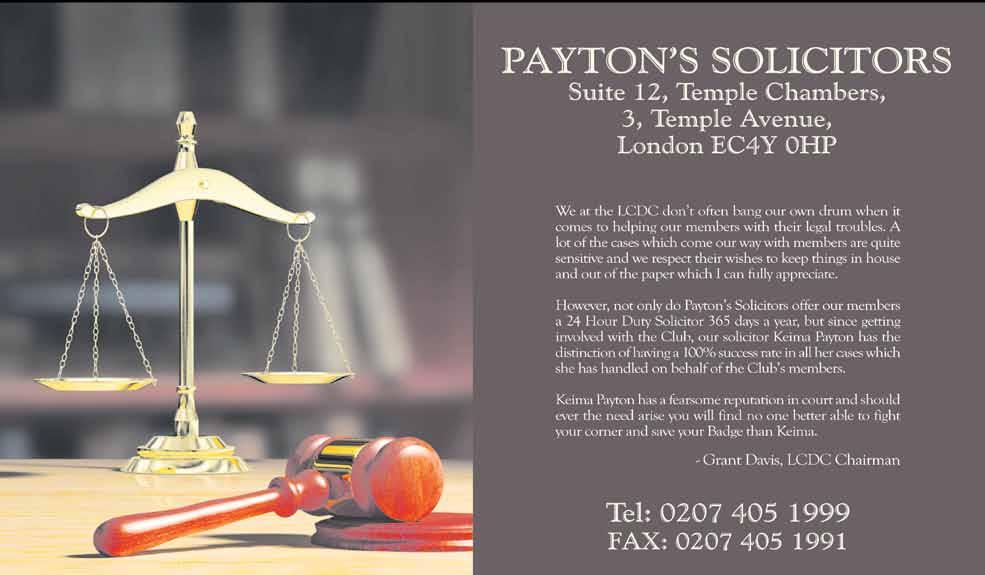
The Chair of the London Assembly Transport Committee has sent two hard-hitting letters demanding urgent action to address the crisis facing London’s taxi trade, criticising both Transport for London and the Government for being “slow to catch up” with the challenges posed by app-based operators.
Elly Baker AM, Chair of the Transport Committee, wrote to TfL Commissioner Andy Lord and Transport Secretary Heidi Alexander MP outlining serious concerns about the 35% decline in licensed taxis over the past decade and the impact of over 106,000 private hire drivers flooding London’s streets.
The Committee’s investigation into TfL’s new Taxi and Private Hire Action Plan, published in March 2025, has been met with disappointment. Driver representatives described the plan as “a missed opportunity,” and the Committee expressed frustration at TfL’s lack of meaningful engagement before its publication.
“We are disappointed with the lack of TfL’s engagement with the Committee before the publication of this Action Plan,” Baker wrote to Lord, noting that despite repeated requests for involvement, the Committee received only an informal briefing just before publication.
The Committee wants to see TfL set a specific target to increase taxi numbers and provide annual progress reports.
“TfL told us that it sees taxis as a ‘really important part of London’s transport mix’ and that its Action Plan is setting out a ‘long term commitment and vision’ for taxis to be a thriving trade,” the letter states, “but we want to see transparency in the specific
targets TfL has to address the declining number of taxis in London.”
The soaring cost of black cabs emerged as a major concern in the Committee’s
is TfL’s refusal to support a cap on private hire vehicles. The Committee heard evidence that the huge number of PH drivers is forcing some to work 16-hour days to make ends meet, raising serious safety concerns.
safety of Londoners.”
The Committee is calling on the Government to:
• Legislate by the end of 2025-26 to grant TfL powers to cap private hire vehicles and stop cross-border hiring

investigation. Evidence heard by the Committee revealed that vehicle costs have rocketed from £47,000 in December 2017 to £70,000 today - with financing costs pushing the total to around £100,000.
The Committee criticised TfL for not exploring alternative financial support mechanisms beyond lobbying government. Baker wrote: “It is clear that TfL is not exploring alternative options to support taxi drivers with the cost of vehicles.”
The letter recommends that TfL explore using the Mayor’s Green Finance Fund to help drivers with upfront costs, stating: “TfL should bring forward proposals for new financial support mechanisms for the taxi trade, beyond the plug-in taxi grant and VAT exemption.”
Call for Private Hire Vehicle Cap
A major point of contention
Helen Chapman, TfL’s Director of Licensing, Regulation and Charging, told the Committee that TfL does not believe a cap is necessary, preferring instead to focus on ending cross-border hiring. But the Committee disagrees strongly.
“Both these issues require urgent attention, and TfL should call for both simultaneously,” Baker wrote. “Given the impact a PH vehicle cap would have on driver welfare and safety we believe TfL must reinstate its support for this.”
In her letter to Transport Secretary Heidi Alexander, Baker called for urgent legislative action, stating: “London is often seen as world-leading when it comes to transport systems. Yet, if we continue to lack the regulatory powers other cities have, we risk attracting bad actors who can exploit drivers and jeopardise the
while they’re behind the wheel, was singled out for criticism.
“It is concerning that this technology appears to be pressuring drivers into committing an offence,” Baker wrote, calling TfL’s approach of simply reminding drivers about the law inadequate. “This approach puts the burden onto drivers, rather than tackling the root cause of the issue - unsafe operator systems.”
The Committee has demanded that by the end of 2025, TfL should make it a licensing condition that operators cannot use technologies requiring drivers to read messages or touch phones while driving.
Both TfL and the Government have been asked to respond by 17 November 2025.
• Mandate data sharing by private hire operators on journey patterns, working hours, and fare structures
• Extend the plug-in taxi grant beyond April 2026 and restore the original £7,500 rate (currently £4,000)
• Make taxis and wheelchair accessible private hire vehicles exempt from VAT by the end of 2025
On financial support, Baker noted: “Originally when the plug-in taxi grant was granted in 2017, it provided £7,500 per vehicle. This is despite the cost of the vehicles increasing over the same time period.”
The Committee also raised alarm about technologies used by app-based operators that pressure drivers to use their phones while driving. Uber’s ‘Trip Radar’ feature, which shows drivers job offers on screen
The Committee has also called for annual verbal briefings to monitor progress.
Baker concluded her letter to the Transport Secretary with a stark warning: “What we are calling for in this letter is not new, but the time to provide it is becoming increasingly urgent. I hope you will agree and can take the actions that are required now.”
The letters represent the strongest political intervention yet in the ongoing crisis facing London’s taxi trade, and will be watched closely by drivers who have long called for action on these issues.
Both letters were signed on 6 October 2025 following the Transport Committee’s investigation in May and June 2025.
TRANSPORT CHAIR SLAMS TFL OVER INACTIONSEE PAGES 8 & 9
The latest accounts from London EV Company (LEVC) make for uncomfortable reading, showing a pretax loss of £179 million for the year ending 31 December 2024, a significant increase on the previous year’s £104 million loss.
While part of this figure includes a £78 million
write-off in vehicles, plant and machinery, the scale of the adjustment raises real concerns that the company may be preparing to wind down, or even cease, production at its Coventry site. Such a write-off suggests a major shift in operations, with assets once vital to manufacturing now being written down in value.
The report confirms that the TX5 taxi, the vehicle that has become the standard-bearer for the London fleet in recent years, is now entering the final stage of its production life cycle.
That news will worry many within the trade,
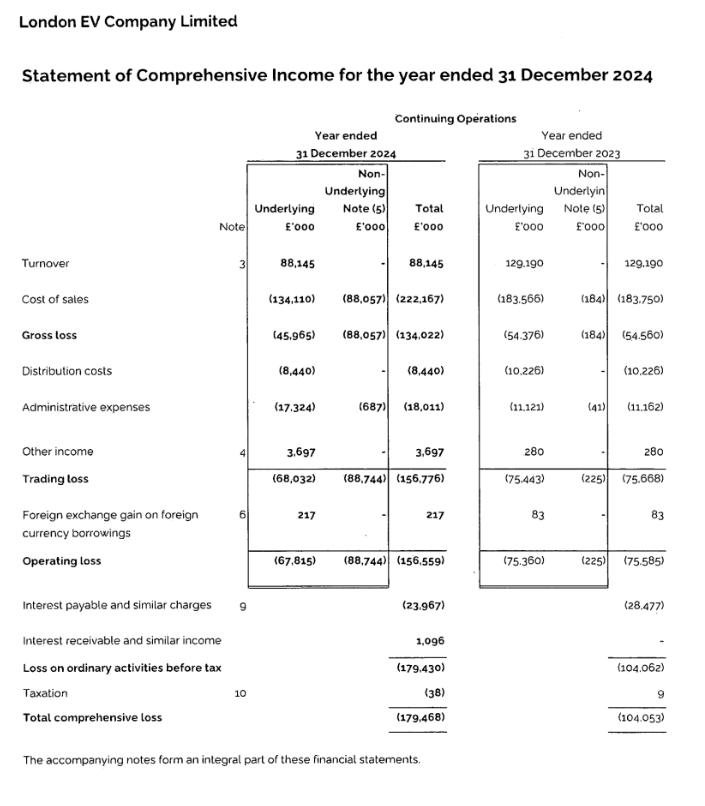



especially with around 2,000 London taxis due to reach their age limit in the near future. There’s some reassurance in the fact that LEVC still holds around £45 million worth of new and used stock, but that can only go so far in meeting ongoing demand. Once that stock is gone, questions remain over what, if anything, will replace it.
LEVC’s accounts refer to a new model, the TX6, but with an important caveat: its development and launch remain uncertain.
Perhaps even more worrying for the UK industry, the company states that it is “highly
likely” any new model will be built in China, not Coventry. That would cast serious doubt over the future of the UK manufacturing base and the hundreds of skilled jobs that depend on it.
In addition, any new model would likely be built on Geely’s “Space Oriented Architecture” (SOA) platform, the same platform used for the L380 MPV. While this could make production more efficient, it raises serious questions about compliance with Transport for London’s Conditions of Fitness, particularly the 25-foot turning circle.
Adapting a mass-market platform to meet that requirement may prove



technically or financially impossible.
These developments come at a time when the London taxi trade is already facing unprecedented challenges. Work levels remain below prepandemic levels, running costs have risen sharply, and the future of electric taxi supply now looks increasingly uncertain.
If LEVC scales back or halts production in the UK, and if no clear successor to the TX5 emerges, drivers could find themselves without a purpose-built vehicle that meets TfL’s licensing requirements!
With so much uncertainty surrounding LEVC’s future, it is vital that Transport for London and the manufacturer provide clear answers. The taxi trade needs to know whether there will be a replacement model, whether it will meet London’s Conditions of Fitness, and where, or indeed if, it will be built.
The black cab is a global symbol of London, but the future of that tradition now looks far from assured. As the company’s accounts make clear, the road ahead for both LEVC and the trade is increasingly unclear.
No wonder the LCDC didn’t get a reply to Grant Davis’s letter to LEVC’s Chief Executive last month. The reply was contained in the Company’s 2024 accounts which were issued on 30th September. And quite a bombshell it was too.
The Statement
Apart from yet more huge losses, the Company states: “The TX5 model of vehicle has entered the final stage of its product lifecycle. The product will be replaced by the TX6 model of vehicle…. Management currently expect TX6 vehicles to be manufactured in China and imported for sale within the UK market. The timing of the development and introduction of this product remains uncertain.” So, we now know that not only is the current TXe taxi on run-out, Ansty will no longer build taxis, but it is seriously in doubt when and even whether we get a new replacement.
The losses
The pre-tax loss in 2024 was a record £179 million. That’s a net loss of £140,000 for every one of the 1,272 TX vehicles sold. And the cumulative losses shown on the company’s balance sheet are now over £860 million. Apart from losses, the only numbers increasing are things like interest costs and stocks. In the first 5 years, 2018-2022, LEVC’s interest charges averaged just over £15 million per annum, but in the last two years they increased by a massive 69% to £25.7 million per annum. Even worse is the increase in finished goods – that’s new and used cab stocks to you and me. They’re up by 160%, from an average of £16.2 million per annum in 2018-22 to £42.3 million per annum in the last 2
years. You’re probably talking over 800 new and used cabs in stock and not sold.
No one involved in the London trade can enjoy looking at those numbers, but can you really blame
cab wholesale stocking plan and other HSBC/ Santander bank loans, over to internal Group funding and lower interestbearing Chinese loans. The company is now 100% owned by Geely UK with the £80 million buy-out of

LEVC for dropping the TXe? It has been a great taxi for London cab drivers, probably the best we’ve ever had. But no company, even one as strong as Geely, can afford to keep throwing money at a taxi market that loses them nearly £1 billion in less than 10 years, and they openly declare their prime target market will continue to decline.
The Board have obviously decided to take the knife to interest costs and stocks. Some say this is aligning production to market demand but, bearing in mind the company’s ‘final stage/ lifecycle’ statement, it might be more realistic to call this a run-out strategy. Cut production, make 180 redundancies in the middle of 2025, reduce the parts pipeline, under-supply new (less than 50 licensed in London in September) to minimise part exchanges, sell the huge levels of used stock, clear the decks and wipe the slate clean. At the same time, reduce interest costs by transferring a lot of external debt, like the new
the third party investor, Natixis SA, in August 2025.
Is there one? Yes, there definitely is. In the short term, by under-supplying the market, TXe used prices should hold up. And there is certainly a longer term future for side-access wheelchair accessible taxis with a strong centre partition for passenger and driver safety. The Mercedes Vito taxi proved it can be done. The Ford Maxicab is ready and waiting to be licensed in London, like it has been in all other major UK cities. We cannot keep saying that London is different and having a 25-foot turning circle is more important than wheelchair accessibility or passenger safety. That will undoubtedly lead us to the endgame. So, that’s why we need an alternative right now, and that is the Ford Maxicab. If Geely does release a TX6 taxi, sometime in the future, it will likely be based on a van or people-carrier made in China, and almost certainly won’t feature a turning circle.

The new VTS combines smart tech and realworld reliability for London cabbies
From traffic to tight schedules, London cab driving brings unique challenges — that’s why VTS was built for drivers with offline protection so payments go through even if the network drops.
But don’t just take our word for it! VTS went through a London pilot under Transport for London’s (TfL) approval process, was tested by real cabbies who rated it “Excellent,” and earned full reliability sign-off.
The old VTS you know and love has been reengineered for today’s cab trade. No hassle, no stress. Bulletproof card payments with VTS’s Offline Mode keep transactions moving with or without connection. London's network can be unpredictable — tunnels, dead zones, and busy areas where signals drop, and that’s exactly when you need payments to work most. Regardless of connection, passengers can still pay by card, contactless, or mobile wallet.
But here's where VTS really shines: it works with the gear you already know. Your taxi meter becomes the heart of a smarter system, calculating fares

while VTS handles the heavy lifting on payments. When the ride's over, passengers see suggested tip amounts that they can easily add and everything runs through a crystalclear 8.7-inch tablet that responds like your smartphone.
Modern taxi driving is more than getting passengers from A to B, it’s about peace of mind. That’s why our TfL-approved taxi CCTV system gives drivers extra protection, reassures passengers, and ensures compliance without complex installs or extra costs.
“Excellent system. Very quick and easy for the passenger to use,” said driver Scott De Garis.
And because great tech should come with great support, Curb has invested
in a new driver hub in Bethnal Green on Three Colts Lane — located with drivers in mind and easy to get to. Our teams in West and North London are also nearby, ready with advice, upgrades, or a helping hand whenever needed.
Built on proven U.S. technology, fine-tuned for the UK, VTS is designed to make drivers’ lives easier. Faster transactions and seamless offline capabilities are tailored to what cabbies actually need. From cash to contactless, swipe or mobile wallets, we accept all forms so that riders can always pay their way.
“It feels like this system was built for cab drivers,” said London driver,
Stephen Jay. “Transactions are quicker, offline mode works perfectly, and I can focus on my passengers without worrying about tech issues.”
VTS is in use across the UK and 65+ markets worldwide, helping over 45,000 cabs navigate shifts without a hitch. Secure payments and integrated CCTV aren’t just tech on paper — they’ve been roadtested so London drivers can rely on them from the first fare.
With every trip, VTS reduces friction: passengers get fast, reliable payments, and drivers avoid technology headaches. International experience shows drivers using VTS report faster transaction processing, smoother end-of-shift reconciliations, and improved passenger
satisfaction scores. The result is not just safer driving but also a more professional service that keeps passengers coming back.
New drivers signing up now can get a £250 bonus, plus 1 year of free meter, and bring a mate to earn £50 for each referral.*
With years of experience working with drivers, Curb knows what matters on the road. VTS is practical, easy to use, and keeps you moving — offline, online, always on.
*Offer valid for new drivers only and subject to change. Terms and conditions apply.
For more information about Curb VTS, call 0333 666 1000 or visit gocurb.co.uk
Date: 3 October 2025
Elly Baker AM Andy Lord Chair of the Transport Committee TfL Commissioner
Dear Andy,
The London Assembly Transport Committee has become increasingly concerned over the past few years about the future of the taxi and private hire (PH) sector in London, carrying out several scrutiny investigations. Most recently, in May and June this year we examined Transport for London’s (TfL) new Taxi and Private Hire Action Plan, published in March 2025.
We are disappointed with the lack of TfL’s engagement with the Committee before the publication of this Action Plan. In March 2024, the Committee wrote to the Mayor recommending that: “TfL should set out an engagement plan for developing the updated Taxi and Private Hire Vision. This should be a participatory process, including engaging with Assembly Members and the London Assembly Transport Committee.”
The Committee wrote to you in October 2024 requesting an update on TfL’s full plan for stakeholder engagement, consultation and production of the Action Plan. We wrote again to Christina Calderato, Director of Strategy, and Helen Chapman, Director of Licensing and Regulation, in December 2024 requesting a copy of the draft Plan for the Committee to engage with.vFollowing this, we received an informal briefing from TfL on the new Action Plan just before its publication. However, we are deeply concerned by the lack of TfL’s meaningful engagement with the Committee on the Action Plan and believe there is a need for more proactive engagement from TfL going forward.
Our investigation this year drew heavily on the experience of taxi and PH drivers and their representatives. Through this work, we have heard strong criticism of the Action Plan from driver representatives. It was described to us as “a missed opportunity”. We believe that the Action Plan could have been more effective had TfL conducted more meaningful engagement.
Given the negative response from drivers’ representatives, and that a key goal of the Action Plan is to make taxi and PH driving an attractive career for current and future drivers, we would like to see TfL make a concerted effort to address industry concerns and engage with taxi and PH drivers directly to work through how the Action Plan can deliver the changes demanded. We are aware that TfL meets regularly with driver representative groups, and believe this engagement should be used as an opportunity to build trust with drivers and deliver the improvements we call for in this letter. This engagement should also feed into the delivery of actions within the Plan given many have a broad delivery timescale of 2025/26 – 2029/30. Christina Calderato, Director of Transport Policy and Strategy at TfL, told the Committee this timescale is because some actions will be multi-stage and require more stakeholder engagement to inform how the next steps will progress. TfL must ensure that this ongoing engagement is proactive and meaningful.
Recommendation 1: TfL should establish ongoing proactive engagement with the Committee on taxi and private hire in London. This should include annual verbal briefings to the Committee on its progress on delivering the Action Plan and the recommendations set out in this letter.
Recommendation 2: TfL should publish an annual Taxi and Private Hire Action Plan progress report, which should be published on TfL’s website and shared with the Committee and taxi and private hire driver representatives.
The advent of app-based operators has irreversibly changed the landscape of taxi and PH, along with a changing approach to road transport policy. We believe that both Transport for London and Government policy have been slow to catch up, leading to a steep decline in numbers of taxi drivers, and concerning evidence about working practices in the PH sector. Given the sector’s importance to integrated transport, including journeys taken by those who may not have other travel options, and all our commitment to road safety, we believe much more should be done. We want to see immediate action in a number of areas, which we feel are missing from the new Action Plan relating to both the PH and taxi sectors.
Private hire
There are over 100,000 PH drivers working in London. The Committee has heard evidence from PH driver representatives that this volume of drivers is causing extreme competition for fares. We heard that it is common among PH drivers to work long hours to earn enough money to live on, and heard of some drivers working 16 hours a day. Working shifts as long as this can result in driver fatigue, and we heard that driving under these conditions is dangerous for drivers, members of the public and passengers. This also raises serious concerns about safety. We believe TfL need to take more proactive responsibility for conditions in the sector.
TfL has previously called on the Government for a cap on PH vehicles,and the Mayor’s Transport Strategy (MTS) states that the Mayor, through TfL, will seek powers to limit the overall number of PH vehicles licensed for use in London. In March 2024 the Committee called on the Mayor and the Government to impose a cap on PH vehicles in London.14 We continue to believe that a cap on PH vehicles is necessary to improve working conditions of drivers and increase the safety of passengers and the public. Yet, the Action Plan does not include this ask. We asked Helen Chapman, Director of Licensing, Regulation and Charging at TfL, about this and we were told that TfL does not believe that a cap is necessary. Instead, we heard TfL is calling for an end to cross-border hiring, stating that this is a more urgent issue and that “the risk is that you get the powers to cap and the loophole with cross border hiring is not addressed”.
The Committee agrees that cross-border hiring is a serious issue, and we have previously written to the Government to call for a stop to this practice. However, both these issues require urgent attention, and TfL should call for both simultaneously. Given the impact a PH vehicle cap would have on driver welfare and safety we believe TfL must reinstate its support for this.
Recommendation 3: TfL should lobby the Government for legislative powers to establish a private hire vehicle cap.
As drivers work longer hours to make up their pay, this can lead to driver fatigue and raises questions around road safety. Increased data sharing by operators as part of their licensing agreements with TfL would enable TfL to monitor the business practices of operators. It would also provide TfL with a better picture of how long drivers are working, how much they are being paid and where they are operating. This would help TfL to ensure that the PH industry is supporting the MTS targets in terms of safety and congestion. Helen Chapman told us that a legislative change is required in order for TfL to collect this type of data. Action 7 in TfL’s Action Plan calls on the Government to make legislative changes to allow TfL to mandate data sharing as part of its licensing agreements. The Committee will also be writing to the Government to recommend this change to legislation, however, TfL’s approach to this matter feels somewhat like passing the buck, and given the importance of these issues to drivers and the public, we believe TfL could be actively exploring what is within its power when relicensing PH operators. To improve transparency, we also believe TfL should publish a PH operator’s licensing conditions as soon as it has issued their licence.
Recommendation 4: To improve the transparency and robustness of its relicensing, TfL should:
• explore conditions, including data sharing, for monitoring the business practices of operators.
• engage with the Committee and organisations representing drivers regarding licensing conditions before issuing licences to private hire operators.
• publish the licensing conditions immediately once a licence has been issued.
As an example of where we believe TfL should use its licensing powers more proactively to ensure driver welfare and road safety is considered, we heard evidence on the impact of algorithmic job allocation through mobile phones. Many app-based PH operators currently use technology that requires drivers to read messages and touch their phones whilst driving. Uber’s ‘Trip Radar’ technology allows “drivers using Uber a chance to see and select requests happening nearby” and that “While driving, Trip Radar requests will appear like offer cards”. We heard that Trip Radar isvdangerous because drivers must touch their phones and focus their attention on a message to read what has been sent or they risk losing work. This raises serious safety concerns.
It is illegal to hold or use a phone while driving. It is concerning that this technology appears to be pressuring drivers into committing an offence. Helen Chapman told us that touching a phone whilst driving “is not something that we regulate for specifically” but that TfL does issue “weekly comms to drivers” on the law around mobile phone offences. This approach puts the burden onto drivers, rather than tackling the root cause of the issue – unsafe operator systems. It also directly contradicts two of the ambitions in TfL’s Action Plan, attracting drivers and ensuring safety. We believe that TfL’s hands-off approach to regulating PH operators is having a serious impact on road safety, passenger safety, and driver working conditions. TfL must be more proactive in taking steps to resolve issues related to large app-based operator systems, such as Trip Radar.
Recommendation 5: By the end of 2025, TfL should make it a condition of licensing that operators do not use technologies that require drivers to read messages or touch their phones whilst they are driving.
Taxi
The taxi industry in London is in decline. In 2013-14, there were 22,810 taxis licensed to operate on London’s roads, but this fell by 35 per cent over the ten years to 2023-24. The Taxi and PH Action Plan demonstrates clearly how the taxis can provide safe options for travel, and black cab is one of London’s most accessible forms of transport, and so the decline has a disproportionate impact on Disabled Londoners. Given this context we are concerned TfL is not taking this decline seriously enough.
We heard from taxi drivers that some of their greatest concerns are access to London’s roads, modernising the Knowledge and the increasing cost of buying and operating a taxi. These are not new issues. In March 2024 we wrote to the Mayor recommending he look at steps to increase competition in the approved London taxi market. We also recommended that the Mayor and TfL should further explore making the Knowledge more modular and should set out steps to encourage and support more women and people from a diverse range of backgrounds to enrol in the Knowledge. We continue to believe action on these issues would help reverse the decline of taxis in London, and would request regular progress updates on TfL’s work to address these issues, in line with Recommendation 1 in this letter.
TfL told us that it sees taxis as a “really important part of London’s transport mix” and that its Action Plan is setting out a “long term commitment and vision” for taxis to be a thriving trade. We welcome TfL’s statement in its Action Plan that it will take steps to halt the decline of London’s taxi trade. The Committee wants to see transparency in the specific targets TfL has to address the declining number of taxis in London.
Recommendation 6: TfL should set a specific target to increase the number of taxi drivers in London.
The Committee has heard that the cost of purchasing and operating London’s iconic black cab is a key barrier to entry for those wanting to join the industry. We heard that in December 2017, the price of a black cab was £47,000 but that now, the cheapest taxi available costs £70,000. We heard to finance it, the cost is around £100,000 with current interest rates.
TfL’s Action Plan states TfL will continue to call on the Government to continue the plug-in taxi grant and remove VAT from the purchase of taxis as options for financial support for taxi drivers. However, the Committee notes that the value of the plug-in taxi grant has continually decreased and the Government has made it clear it does not intend to remove VAT from taxis. The Committee therefore believes that TfL must start considering other forms of financial support for taxi drivers, on the cost of purchasing and financing vehicles, that can be brought in quickly and provide long-term reassurance to those wanting to become a taxi driver.
The Committee asked TfL if they are considering any alternative measures to financially support taxi drivers. In response, TfL told us about its de-licensing scheme that is no longer running, and that it continues to lobby Government for the plug-in taxi grant and wheelchair accessible VAT exemptions. It is clear that TfL is not exploring alternative options to support taxi drivers with the cost of vehicles. We heard that the Mayor’s Green Finance Fund could be used to solve the problem faced by taxi drivers in terms of the upfront cost of the taxi. Future rounds of the Mayor’s Green Finance Fund will be subject to the availability of funds. But, we believe this funding stream should be explored further.
Recommendation 7: TfL should bring forward proposals for new financial support mechanisms for the taxi trade, beyond the plug-in taxi grant and VAT exemption. This should include exploring using the Mayor’s Green Finance Fund.
I would be grateful if you could respond to this letter by 17 November 2025.
Yours,
Elly Baker AM, Chair of the Transport Committee

THEN AND NOW
What’s he going on about, you ask. This is the name the Yanks give to Deliveroo riders and their ilk.
If we compare today with 1977, our figures don’t look too bad.
The UK has its own “Burrito Taxi” problem and it doesn’t apply only to these services but also the gig economy as a whole. The gig economy is built on exploiting its labour and this includes the likes of Uber. They treat such workers as food delivery riders, App PH drivers, etc as self-employed when they should be employees with all the rights and safeguards that employees enjoy.
In 1977, we had a fleet of 12,452 cabs. Today, we currently have 14,803, an increase of nearly 20%. Equally, in 1973 we had 16,474 drivers, against the current number of 17,356, making an increase of nearly 10%.
boss of Deliveroo how much tax his company saved by not treating its riders as employees? Make no mistake, it may not seem like it but the money these companies avoid paying in tax is out of your pocket and mine. The taxes they pay, pay for the welfare system. Less tax, less hospitals and staff, increase in the retirement age for pensions, etc; for roads and repairs. So, the more tax they avoid, the less money available for the above.
regard of driver employment would effectively double. This would result not only in rising prices but also reducing demand. Some of that reduced demand would find its way into the back of your cab. It would also reduce the number of PHVs blocking your way, causing traffic jams, etc. Your ability to drive around London would also be helped by the reduction in food delivery bikes as faced with a proper cost of delivery, people would start collecting there KFC themselves.
with sat-nav equipped drivers who no longer have to memorize routes. Tighter environmental standards pushed up the costs of vehicles. Councils blocked favourite cut-throughs. Over half of London’s roads now have 20mph speed limits. Since 2017 the number of black - cab drivers fell from about 25,000 to barely 16,500, according to TFL.)
There you go, the Economist gets it. Why doesn’t TFL?
allow a range of vehicles that could meet all other CoF’s. This competition would reduce the cost of vehicles. Having to meet the other CoF’s would mean that such vehicles would be similar in shape and size and if all a single colour, would be every bit as recognisable as a current taxi, if not more so.
wheelchair accessible but only 0.5% of PHV were accessible.
Firms in the gig economy like to pretend that they are giving their riders and drivers the freedom to work when it suits them, etc. The reality is that they are often modernday slavers, virtually forcing their “contractors to work long hours to make a living, sometimes dangerously so.
The problems created by the gig economy runs deeper than that. Due to the Supreme court decision and definition of Deliveroo riders et al, the sector can and does act as a draw for those people coming over from Calais in rubber rings. If they get into the country, they can effectively work in the gig economy.
Looking at these figures, its not unreasonable to ask why some in the trade, including myself, are worried for its future. But this doesn’t tell anything like the whole story. Its when you look at the KOL (Knowledge of London) figures, that the problems become clearer. In 1973, there were three times as many KOL students as there are today. Then, it took less than half the time it does today to pass out. That means that there were effectively six times as many KOL students over a 4yr period.
This old geezer passed out in December 1979 and it took me 19 months, doing it part-time. Today it takes more than 4 years, on average. There is an argument that the KOL is harder today, than it was then, but I would dispute that.
The Labour government have plan to bring in a sweeping Employment Rights Bill this autumn, if they have the bottle to carry it through. This will affect all the gig economy, including the likes of Uber.
While in opposition, the Labour party opinion was that this “worker” flexibility was a weakness of the general economy, keeping employment low and corroding family life. While in opposition, Chancellor Rachel Reeves asked the
It can be argued that places like The Docklands and E20 weren’t part of the KOL in my day. Against that though, denied road access means that most runs will be simpler today. For example, the rat run from Oxford Circus to St Giles Circus required calling 11 points Similarly, it is no longer possible to use the rat run between Guildhall and Southwark Bridge Rd. There were plenty more like this that have gone today.
Viewed over the last 10 years, the problems become clearer and it is no coincidence that it’s the same period of time during which Uber first gained a serious foothold in London. From 2014 to September 19, just prior to Covid, the
number of drivers fell by
In power though, the
YOU. YEAH, YOU!
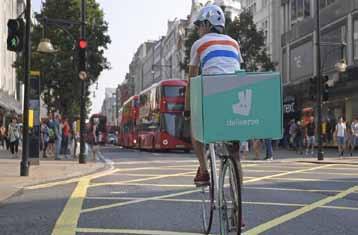
government are wobbling a bit. If this bill is pushed through, it will put up gig firms costs and this will be passed on to customers using PH and having food delivered, etc.
a ridiculously expensive vehicle became compulsory, driver numbers are still down by 5,562 and cabs down by 4,331 on those 2019 figures. KOL
Uber and the like are getting away with it at the moment. The court ruling forced Uber to treat their drivers as workers but it left them a loophole. They are able currently to claim that their drivers are only employed while they are carrying our fares. This means that while they receive employee benefits, in particular minimum wage, Uber are only liable for about 50% of the work their drivers do.
On current numbers, we’ll be lucky to see more than 200 new drivers annually. Back in 2014, the GLA FP (Future Proof Report) warned about this situation, while the Mayor and TfL sat, and continue to sit, on their hands instead of doing something useful and positive. They pointed out then that more than 40% of drivers were aged 55 or over.
You can play your part. It only takes one, short email. This is how you do it. Go to www.parliament.uk in your search engine. Next, scroll down to quick links and tap. Then, click on the MP and Lords box and then put in your own address, MP name of your constituency to find your MPs email address.
– meter co.s, fleets, vehicle manufacturers, repair garages, etc – be able to continue serving our trade? Then what?
For several years now, TFL have worried about falling numbers, particularly the KOL. They fanny about, coming up with all sort of ideas and schemes that tinkered around the edges and failed, rather than face the truth of why the cab trade is dying and nobody is doing the KOL.
The quote above is clear: 1/ Why would a new driver spend 3 to 4 years and an estimated £10,000 personal cost, when he or she can start driving almost immediately by buying a sat-nav and signing up to a ride-sharing App?
The KOL needs sorting out badly. It doesn’t need watering down as it is what makes our trade what it is and what it has always been. Come on, though. If I could do the KOL in 19 months in 1979, does it really need to take 4 years today? Really? Are today’s K students really that much thicker than me?
Then send an email (or post to The House of Commons) asking for your MPs assurance that he/she/it will be voting in favour of the forthcoming “Employment Rights Bill” in its current form. 15,000 such emails would give your MPs something to think about.
At this rate, even if we don’t take leavers from the trade into account, at current pass out rates, it will take until 2051 before we get the number of drivers back up to 2019 numbers. In reality, there are currently far more drivers leaving the trade than there are joining it and so our number is more likely to fall.
If this bill were to go through, Uber’s costs in
We only have a fleet of 14,408 cabs now. How long before that figure drops to 10,000? Scare-mongering? I think not. Andi if it does? At
Let me start this with a quote from The Economist. “London’s cabbies have had a hard few years. Ridehailing platforms such as Uber upended the market,
SOLUTION: Stop allowing drivers that are unqualified for the job from working as pseudo-taxi drivers without testing their knowledge, driving skills and suitability to do the job.
“When did you get out?” “1990”. “How long did it take you?” “36 months”. “36 months, well you must be really thick because it only took me 19 months.” I’d probably get a punch in the mouth if I had that conversation in a café. So, why does it take more than twice the time it took 45 years ago? It isn’t because the streets are more numerous and complicated. It isn’t because today’s students are much thicker. It can only be one thing and that’s the administration.
3/ LTNs are increasing fares to passengers by up to 50% in extreme cases such as exists in Islington. Customers have to pay more and time wasted reduces driver earnings. Nobody wins.
SOLUTION: allow greater access for taxis into LTNs.
4/ 20pmh speed limits have their place but they are over-used. They are proven to have improved safety. One should not expect otherwise and that is a good thing. However, they are not exclusively good everywhere.
got your suburbs. On these you would be asked about 6 straightforward runs and you either got through immediately or were asked to come back later in the day to review any that you did wrong or maybe asked back a second time and then you got your badge and bill.
The current system was supposed to streamline the K when what is has done in reality is double the time required to pass and for no good reason.
2/ The cost of the vehicle is too high and is part of the reason that some cab drivers decide to pack it in and deters some potential KOL applicants.
SOLUTION: remove the CoF with regard to the “turning circle” and introduce a new CoF that makes all new cabs black in colour. Also, bar any new PHVs from being coloured black or a colour that could be mistaken for black.
This would have the effect of maintaining instant recognition of “the icon” and
When I di the K, you started with 2 x 56 days (which were 90 days in reality. You then went on to 28s. After about 12 appearances on 28s, you went on to 21s. Your drive took about 3 weeks from
Their recommendation was that the number of accessible PHVs should be increased over time to 25%. Its still only 0.5% and TfL doesn’t give a toss about the disabled or the equality Act. The situation is actually worse now. While PHVs were pre-booked, there was a case for them being only 25% accessible. Now though, with immediate street hiring of PHVs, a disable person, that is supposed to have an equal opportunity of booking a PHV, has only a 1 in 200 chance to book one, against the chances of an ablebodied rider. If they are going to allows electronic hailing by PH, all PHVs should be accessible. If Uber and its ilk were a cinema, theatre, shopping centre, etc, it would immediately be closed down.
TFL: COULDN’T RUN A BATH
In respect of cab drivers, this can be very stressful. Of course it is a good idea to have a 20mph limit on back streets. But, try telling a passenger it’s a good thing when they are trying to get home as 11.30pm and sitting in a cab doing 20mph on the main south circular.
Our nutty Mayor needs to stop kow-towing to the Lycraclad, cyclo-terrorists and be sensible about his plans for future of London’s roads. Too much, too fast. I would argue that it is sometimes safer for a cab driver to be doing 30mph than 20mph with his concentration being taken away by a passenger in her ear to go faster. Just this week, we had a member packing it all in because of these last points.
At the same time, TfL have been unable or unwilling to prevent PH becoming a pseudo-taxi service. With the advent of Apps, the customer no longer prebooks a ride, as per the law, but just opens a phone, looks at the screen for cars in the area and electronically hails a PHV that is cruising the streets or parking in busy areas. What kind of idiot will spend 48 months doing the K today when he/she can spend just 4 weeks in order to drive a pseudo-taxi?
Otherwise, let Khan man up and do what he really wants to do and ban private vehicles from the centre of town. Rip the plaster off instead of picking at it.
Back in 2014, FP pointed out that 14% of taxi users and a greater number – 19% - of PH customers were disabled. They recognised
One of our members, Andrew, sent in his licence renewal early in the new year. When he hadn’t heard back after two months, he eventually managed to contact TFL. They’d lost his forms and by then, he needed to redo his CRB check again. He duly did this and then nothing happened again. He then got The Club involved and frankly, we did not do any better at first. Andrew’s licence eventually ran out and he could no longer work. The Chair, Grant, involved the two top bods that deal with taxis at TFL. At first, all he got was promises, excuses and blame. By the time it finally got sorted out, Andrew had not only lost eight weeks’ work through TFLs ineptitude, he also paid his cab rent throughout the period out of fear of losing the cab if he handed it back. At time of writing Andrew still doesn’t have his bill but he has an email granting permission to drive the cab. You would think TFL would be shame-faced and at least offer an apology. Nah, the day before the email arrived, they were still trying to blame Andrew himself, for the delay.

"Indicators aren’t optional. It’s not a guessing game — it’s the highway, not a telepathy test."
We’ve all seen it — the daily chaos that unfolds on our roads. You don’t have to be a perfect driver to notice it. Whether you’re walking to school, sitting in the passenger seat, or behind the wheel yourself, bad driving seems to be everywhere these days.
And it’s not just annoying — it’s dangerous, selfish, and, frankly, enough to make anyone lose their patience. From the lane drifters who can’t seem to choose a side to the tailgaters glued to your bumper like magnets, every journey feels like a test of nerves. The road is supposed to be a shared space — but some people act like it’s their personal racetrack.
Let’s start with one of my biggest irritations: the lane drifters. You’ll be cruising along happily, when suddenly the car ahead begins to wander between lanes like a lost shopping trolley. No signal, no awareness — just pure confusion. And then there’s the Sunday driver, who seems to think every road is a country lane and every day is a lazy afternoon drive. Crawling along at 40 in a 60, blissfully unaware of the mile-long queue building behind them. Being cautious is fine — being completely oblivious is not.
Ah yes, the elusive indicator — the one car feature that seems to vanish as soon as people pass their test. Some drivers act like signalling is beneath them, as if letting others know their intentions would ruin the

suspense. It’s such a simple gesture. A tiny flick of a lever could save confusion, frustration, and accidents. But no, apparently it’s too much effort.
Then there are the tailgaters — the impatient souls who believe that sitting inches from your rear bumper will somehow make traffic disappear. You could be doing the speed limit, yet they’re right there, so close you can see their frustration in the rear-view mirror. It’s not just irritating — it’s dangerous. One sudden stop and bam, you’ve got a two-car pile-up because someone couldn’t handle waiting.
We’ve entered the era of the phone zombie — drivers who simply can’t resist checking their screens. You see them everywhere: heads tilted down at the lights, thumbs flying while they roll forward, eyes flicking between the road and their messages.
It’s terrifying. Five seconds of distraction at 50 mph is
enough for a car to travel the length of a football pitch completely unsupervised.
Ah, the car park — the real jungle of modern life. Watch long enough and you’ll see every kind of bad parking imaginable.
The double-space hogger who straddles two bays because “it’s a big car.” The pavement parker who leaves pedestrians to squeeze past. The eternal reverser who takes three full minutes and eight attempts to back into a space.
At one end of the scale, you’ve got the speed demons — the daredevils who treat every road like a Grand Prix circuit. They zoom past, overtaking on blind bends, convinced they’re invincible. Then there are the slowpokes. The overly cautious types who seem to think the accelerator pedal is optional. Sure, it’s good to be safe — but when you’re doing 25 in a 50 and causing a queue behind you, you’re not being careful. You’re being inconsiderate.
someone tailgates, speeds, or texts at the wheel, they’re risking lives. Most of us like to think we’re “good drivers,” but we all have habits worth checking. Maybe we forget to signal, or we get impatient in traffic. The trick is to recognise it and do better — because driving isn’t about showing off; it’s about keeping everyone safe.
Roundabouts. A simple concept, but you wouldn’t know it from watching some drivers. You’re supposed to give way to the right, keep moving, and use indicators. Easy, right? Apparently not. Some drivers freeze like rabbits in headlights, waiting for a completely empty circle before daring to move. Others charge straight in like they own it. And then there are the ones who go all the way around twice because they missed their exit — again.
Let’s not forget the zebra crossing offenders — those drivers who think pedestrian crossings are mere suggestions. You step forward, they speed up. You hesitate, they glare as if you’re the problem.
A zebra crossing isn’t a challenge; it’s the law. If someone’s crossing, you stop. Simple as that.
Behind all the frustration, there’s a serious point. Bad driving isn’t just irritating — it’s dangerous. Every time
The one thing that really drives me mad are the lane jibbers, just picture the scenario, you are sitting in a line of traffic at an exit slip of a motorway, everyone is queuing patiently, a driver continues along lane one, bypassing all of the traffic and tries to jib into the queue of cars at the last opportunity, virtually stopping in lane one, causing traffic to brake sharply or take evasive action to avoid a collision, not only are they putting themselves in danger but they are endangering the lives of motorists behind them. What makes these entitled individuals think that it is, OK? Are they just ignorant people that have no concern for other road users, are they arrogant people who only think of themselves? Whatever their reasons or thinking jibbing in like this is not right and annoys everyone.
In the end, the solution is simple. Driving is a shared responsibility. If everyone showed a little more patience, used their indicators properly, parked with care, and left their phones alone, the roads would be calmer — and everyone would arrive in one piece.
So, to all the lane drifters, tailgaters, and phone zombies out there: please, for everyone’s sanity, sort it out.
Because good driving isn’t about getting there first. It’s about getting there safely — and keeping the rest of us from losing our minds along the way.


At Mayor's Question Time, Khan always waffles on, changes the subject and fails to give direct answers to questions.
We all know what a mess he’s made of London, using LTNs, ULEZ and such as no more than a cash cow!
If he was the CEO of a company, he would have been removed over his actions, but Khan appears to be untouchable in his present position.
GLA councillor Emma Best, tried desperately to get him to answer questions about the results of the LTNs at Mayor's Question Time, and he failed to give even one direct answer.
According to Cllr Best in an online video of MQT, when talking with TfL staff and presented with the results that showed LTNs had no benefit to local traffic or an increase in air quality, he said "there's

nothing in these reports that we can use, it’s just a lot of text and numbers that won’t help us"…. he went on to say, "it's a bit underwhelming but offers the fact that the results could be contextualised into a caveated summary that TfL could in-fact publish."
Cllr Best continued: "this follows on from the previous deputy Mayor for environment Shirleys Rodrigues (2016-2024) suppressing information on ULEZ when she didn’t like the outcome… are you concerned with this at all?"
Khan said he didn’t think
this was a smoking gun, or a conspiracy. It was just there wasn’t enough data to complete the study, so he decided not to complete the study.
Cllr Best said "there were four thousand five hundred replies completed… that’s four thousand five hundred Londoners that gave evidence…yet you

are putting out press releases to the Evening Standard after getting just 12 positive responses on X (formerly Twitter) on Oxford Street."
So, again… what use is the GLA who are supposed to be able to hold the Mayor to account? Why is he still Mayor of London?
Also in the news, we find out that TfL have employed over 500 migrants who haven’t been granted leave to stay in this country…and that’s apart from the thousands who have been granted PHV licences, with no criminal record checks whatsoever.
So, what use is the GLA who are supposed to be able to hold the Mayor to account? How much longer must we endure this situation of an untouchable Mayor? Surely we need legislation in place to stop this happening again in the future?


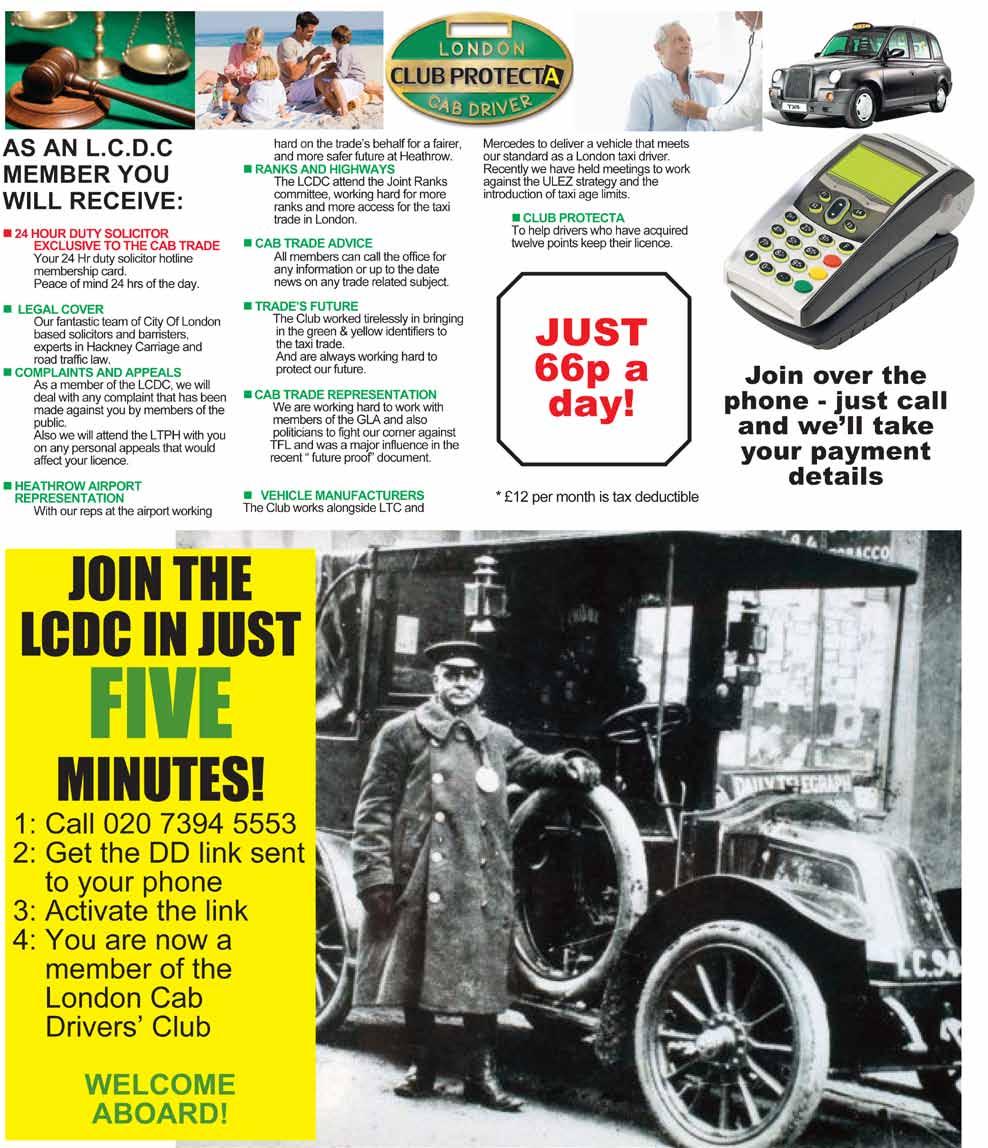
Waymo, a division of Google’s parent company Alphabet, has announced that it is expanding its robotaxi operations to London.
It will be the first European city to support the autonomous ride-hailing service, with the first vehicles rolling out over the coming weeks.
Waymo is the world’s leading robotaxi service, with a fleet of 1,500 selfdriving cars serving Atlanta, Austin, Los Angeles, Phoenix and San Francisco in the US.
The first expansion to international markets was through testing sites in Tokyo, with the London rollout expected to be the first in a European expansion.
“Waymo is making roads safer and transportation more accessible where we operate,” said Waymo chief executive Tekedra Mawakana.
“We’ve demonstrated how to responsibly scale fully autonomous ridehailing, and we can’t wait to expand the benefits of our technology to the United Kingdom. ”
The first cars in the UK will come with human safety drivers behind the wheel, but working with the Department for Transport and Transport for London, Waymo hopes to introduce fully autonomous rides in 2026.
“I’m delighted that Waymo intends to bring their services to London next year, under our proposed piloting scheme,” said secretary of state for transport Heidi Alexander.
The company already has a fleet of 1,500 driverless cars in the US
The company already has a fleet of 1,500 driverless cars in the US (Getty)
“Boosting the [autonomous vehicle] sector will increase accessible transport
“Cutting-edge investment like this will help us deliver our mission to be world leaders in new technology and spearhead national renewal that delivers real change in our communities.”

options alongside bringing jobs, investment, and opportunities to the UK.
A recent report from market research firm IDTechEx noted that no
robotaxi service has yet made a profit, though this is expected to change as operations expand. The authors forecast that revenue from robotaxi software would increase more than 1,000 times over the next 20 years, reaching $136bn by 2046.
Regulatory challenges, technical difficulties, as well as public perception of the technology could all impact whether this prediction is achieved.
“Robotaxis are still in an extremely nascent stage,” the report stated. “As companies look to scale up to tens of thousands to potentially millions, any small error or delay could prove extremely dangerous.”
Courtesy of The Independent

London will be left with just two Metropolitan Police stations with front counters operating 24 hours a day, as ten more are set to close under cost-cutting measuresbreaking a pledge made by the force and the mayor of London.
The number of front counters where the public can speak to officers will drop from 37 to 27, and be staffed between10:00 to 22:00 on weekdays and 09:00 to 19:00 on weekends.
Only Lewisham and Charing Cross - where ten officers are currently under investigation by the police watchdog - will remain open 24 hours.
The Met said it would save £7m but some of its staff and victim support groups say it could leave some people at risk if they
need face-to-face contact. The force added it needed to make £260m worth of savings by reducing services and cutting about 1,700 officer and staff roles.
Approximately 5% of crime is reported to front counters, which equates to about 50,000 of the one million crimes reported in London annually, the force said, adding the changes will free up about 2,900 hours of police officer time per month.
Assistant Commissioner Matt Twist said: "The Met is having to shrink to live within its means and, as the public would expect, we are targeting our resources on a narrower set of their priorities to make London safer."
The Met had initially planned to permanently cut the number of publicly accessible front counters
from 37 to 19.
London Mayor Sir Sadiq Khan - who oversees the Met's budget and had
possible without recordbreaking funding from City Hall," he added.
In 2013, London had

made a manifesto pledge to have at least one 24-hour counter open in each of London's 32 boroughs that the Met operates in - said he had "resisted closing front counters unless we really had to do so".
"Whilst this is an operational policing decision, this action would not have been
nearly 140 front counters, but the then mayor Boris Johnson closed 65 of them. In 2017 when Sir Sadiq was mayor, a further 38 were closed.
The Met had committed to having at least on front counter open in each borough 24/7 in its A New Met for London, external strategy.
The force added Londoners could continue to be able to book appointments to see an officer and report a crime, access video appointments, phone 999 and 101, report online and contact their local ward officers.
Phones will be installed outside closed front counters.
Stations set to close are: Barking Learning Centre, Barking and Dagenham Chingford, Waltham Forest Church Street, Westminster Harrow Kensington, Kensington and Chelsea Mitcham, Merton Pinner (volunteer) Royalty Studios, Kensington and Chelsea Twickenham, Richmond Wimbledon, Merton
Courtesy of the BBC

In the days of the old Carriage Office, The main concern was public safety. The driver and the vehicle came a close second but were essential to assist the primary concern of public safety.
the one we currently receive. We had far more people on the knowledge being tested, an office we could go into to speak to someone, a place to hand in our bill renewals (which they checked over for you) paying in cash if we wanted, and the onus
my badge, the examiner told the class they had to register with the Inland revenue but that was as far as their reach went.
Now they want tax codes, license codes, DBS checks, this new Seru malarky, and more,
computers from the comfort of your own armchair, but I never experienced the stress you now get from trying to sort out your bill or overhaul under the old fashioned, archaic, dinosaur that was the PCO. And let’s not forget
The carriage office were feared at times but they were also respected. Respect and admiration came the other way, I’m sure, as they knew what we had to go through to get our badges and keep our cabs up to scratch. Fast forward to today and we are now being run by swathes of wannabe politicians, bureaucrats and office workers who just don’t seem to have a clue what it is we do.
In the August edition of The Badge, the LCDC reported that a member reminded Transport for London (TfL) through a court claim that traditional taxi laws are still in force.
In response to this claim, TfL’s legal department clarified a key issue raised by our member: whether a taxi driver may start the meter upon accepting an immediate app-based booking. TfL replied:
We have a licensing authority who are happy to turn a blind eye to the failings in public safety so common with our competitors. In a fight to combat this, more and more rules and regulations are brought in instead of harsh punishments and firm decisions, and we are expected to follow these directives too even though we really aren’t the problem.
“TfL has already confirmed to you in correspondence dated 21 May 2024, that a hackney carriage driver may not switch on the taximeter prior to the point at which the passenger is picked up, when it is being pre-booked as a hackney carriage. Again, we consider that this point is clear and does not require a declaration from the High Court before that is the case.”
The authority is awash with public money yet is £billions in debt, always needing bailouts. As far as I’m aware, the Public Carriage Office was never in debt, and they offered a far better service than
This statement from TfL appears to contradict a 2017 statement made during a trade meeting with

organisations like the LCDC, LTDA, Unite, RMT, and UCG, where TfL stated: “…case law has determined that a hiring for a London taxi takes place where the booking is accepted, not where the passenger is picked up.”
This 2017 statement was related to a case involving yellow badge taxi drivers working for Computer Cab, addressing whether they were plying for hire in the green badge sector. Given that TfL understands that hiring occurs at the booking location, it should also recognize that Section 39 of the London Cab Order 1934 permits the meter to start from the acceptance point. Section 39 of the Cab Order 1934 specifies: “The driver of a motor cab shall start the taximeter no sooner than when the cab is hired or at such later time as the driver thinks fit.”

was on them to check your criminal record and driver license record.
They even gave us an extra driving test that also made sure we knew how to load a wheelchair customer safely and respectfully. They knew you were ‘fit and proper’ and of a good standard of English because of the way you and your temperament were tested on the knowledge. I remember upon receiving
This inconsistency raises questions about TfL’s taxi and private hire department? Drivers are asking if they are
potentially favouring the commercial interests of app companies?
These companies, also licensed by TfL as private hire operators and contribute substantial revenue through licensing fees, could this be a conflict of interest?
TfL has stated that it does not regulate taxi apps, an assertion that seems intended to deflect responsibility for protecting both the public and taxi drivers.
legal framework for London’s regulated taxi service.
By treating taxis and private hire vehicles similarly and allowing app companies to do the same, TfL may be acting unlawfully?
Since taxis perform a public service, the app companies that dispatch them also perform a public function, thereby falling under the PSED, which TfL is tasked with enforcing.
Private hire and the big global corporates have clearly benefitted the most but also, by their sheer number caused by their ease of licensing, contribute the most to the coffers. Could this be why there is a clear sense of favouritism towards these ‘paymasters’ and a willingness by our shared regulator to turn the other way when they flout the law? It’s getting frightening how they want more and more control over us and our lives though.
cancellations if drivers are not compensated from the moment of booking acceptance, as case law and the London Cab Order allow.
all done at our own expense and they won’t allow us to see someone in an office if we need a bit of help with whatever they request. Soon they’ll be wanting our inside leg measurements, given by a qualified tailor that we’ll have to pay over the odds for, like many do with their medical from their own doctor.
All of this is supposed to be in the name of progress, using
However, case law classifies taxis as public transport, unlike private hire vehicles, which are categorized as private transport. As a result, Section 149 of the Equality Act 2010 requires TfL to fulfil its Public Sector Equality Duty (PSED) when third parties, such as app companies, dispatch taxis. Therefore, TfL’s claim that it does not regulate apps appears misleading; it has a statutory duty to ensure that these apps operate within the
there was half as many more of us back then.
The PSED mandates that TfL eliminate discrimination, harassment, victimization, and practices that endanger the public. Therefore, TfL cannot permit app companies or drivers to cancel bookings, which could leave passengers, particularly those relying on contracted services in a vulnerable situation if drivers cancel the app job in Favor of a street hail.
So who is actually benefitting from the creation of London’s authority and TfL? We have an army of state employees, many earning way over £100k with great pensions and perks.
Most high positions given to those who follow the political line of the Mayor at the time; hundreds of ‘jobs for the boys’.
TfL’s policy requiring drivers to start the meter only when the passenger is picked up may lead to app booking
Moreover, TfL's PSED duty includes maintaining regulated fare limits. Added fees, such as technology charges, high-demand fees, and surge pricing may make a taxi unaffordable for vulnerable passengers, including wheelchair users and disabled individuals who may already be financially disadvantaged.
You only have to look at the way we’ve had credit cards foisted upon us, only with machines ‘approved’ by them which has a knock on effect to our incomes. Then there was the ridiculous decision to force us (less than 1% of the vehicles in London) into an over priced, unreliable, electric vehicle that hadn’t even been built and tested with no infrastructure existing, way before anybody else is made to with a much bigger variety of options.
Do they not know we need a reliable, workable cab to earn an average London wage? Lions and donkeys can only come to mind.
In conclusion, TfL’s claim of non-regulation over apps seems disingenuous given its statutory duty to safeguard public welfare in taxis, a form of public transport distinct from private hire vehicles.
In short, and in my opinion, TfL are going way beyond their remit. Call me old fashioned but the days of yore seemed far less complicated than they are now.
There is a pressing need for government intervention to address TfL’s apparent shortcomings and potential biases that continue to affect the London taxi industry.
Progress? Don’t make me laugh!
TfL has been contacted for comment.
The growing scale of theft and vandalism targeting electric vehicle charge points has been laid bare in a new report.
The data from gathered from police forces has revealed more than 200 attacks on EV chargers across the UK costing millions of pounds.
However, charge point operator (CPO) Allego UK, who commissioned the research, is warning that this is just the 'tip of the iceberg' and calling for a crosscollaborative 'EV taskforce' to explore ways to better protect charge points.
Allego is cautioning that many incidents go unreported and that 40 per cent of surveyed police forces are either unable to provide data or say they don't have relevant records.
The charging industry - a vital pillar in the country's push towards EV uptake, clean transport and Net Zero - wants to raise awareness that as the EV network continues to expand so too does the opportunity for criminal activity and that preventative action is critical.
The report's findings align with exclusive insight given to the Daily Mail and This is Money by the leading charging operator, InstaVolt.
It revealed the spate of charging cable thefts that is impacting all charging point operators forcing them to use state-of-art security measures to stay ahead of organised crime and make sure that driver experience isn't impacted.
A new FOI has found that EV charging cable theft and vandalism targeting is growing - and it's all because of the rising price of copper

Paz Sharma, managing director of leading charge point operator Allego UK has joined growing calls for EV chargers to be recognised as critical infrastructure and for harsher penalties for those caught targeting these sites.
His calls for the crosscollaborative 'EV taskforce' would see government, industry, law enforcement, the industry body ChargeUK and political groups like the Electric Vehicle All Party Parliamentary Group join together to explore ways to better protect charge points.
Paz also emphasised the role of industry in putting criminals on the radar of authorities and has written to both the Home Office and the National Police Chief’s Council calling for the creation of a virtual hotline for reporting EV crime.
He said: 'While we are far from crisis mode, this research is a warning sign that action needs to be taken to bring EV criminals to book.
'It’s not about the £25 scrap metal value or even the cost of replacing damaged chargers which runs into thousands of pounds – it’s about giving the nation the best chance of securing its clean transport future.'
Earlier this week, The Telegraph reported a rise in charging cable thefts that saw operator Evyve claim an estimated 100 chargers had been targeted in the last 12 months (a third of its entire UK network of devices). Osprey also said one in ten of its chargers were out of action this summer due to cable thefts.
Thieves are targeting cables because of the soaring price of copper.
Copper prices climbed 3.7 per cent between September and October as global supply contracted following production losses at Indonesia’s Grasberg mine.
InstaVolt, Britain's largest rapid charging network,
spoke to Daily Mail in depth about the issue.
'The key bit we want drivers to know is that InstaVolt is replacing these charging cables within 24 hours,' InstaVolt CEO Delvin Lane told us.
'The last thing we want is for drivers to have a lack of confidence in charging infrastructure.'
Other than 'replacing all cables in 24 hours', Delvin explains the company has rigourous and industryleading security measures in place.
'For us it's about staying one step ahead of the criminal, with a range of measures', he says, 'in three steps.'
Delvin Lane, InstaVolt CEO told us that the company uses a threestep proccess: EV cable guards to ward off thieves, 24/7 CCTV and real-time live GPS tracking all built into the cables - at huge cost.
The first step by InstaVolt was introducing a patentpending EV cable protection system called CableGuard which adds a critical layer of security without affecting the driver experience; this is a sheath that encases the cable and is forensically traceable.
The second physical deterrent Delvin says is CCTV. As we've seen first hand when visiting InstaVolt's new Winchester Superhub with its team, InstaVolt's 24-hour CCTV is vigilant.
InstaVolt sites have 24/7 AI-powered CCTV systems capable of identifying suspicious activity in real time and security patrols.
Thirdly, Delvin says, is that InstaVolt is now rolling out real-time live tracking GPS. The Trackit247 tech provides real-time updates every three seconds allowing InstaVolt to not only deter theft but also work with police to trace and recover cables and detain offenders in real time.
All of this is because charging is 'all about driver confidence' Delvin reiterates, and police are 'already burdened'.
The situation is serious and 'can't continue to see cable losses like it' Delvin warns, because, while InstaVolt can handled 'the burden' as it is commercially profitable CPO with 'economies of scale' many other CPOs aren't and are left with a choice between 'building their network and replacing the cables'.
While once opportunistic one-off crime, InstaVolt is now convinced like other CPOs and the police that it's organised crime.
Courtesy of Thisismoney.co.uk

The London Cab Drivers Club (LCDC), representing the professional and licensed taxi drivers serving Heathrow Airport, firmly rejects Heathrow Airport Limited’s proposal to remove the Taxi Feeder Park (TFP) from the Other Regulated Charges (ORC) framework and convert it into a commercial operation.
Only two years ago, Heathrow attempted to move the TFP into a commercial arrangement, and the trade made its position absolutely clear then — the Taxi Feeder
Park is an essential part of London’s public transport network, not a commercial venture. The current proposal is nothing more than a renewed attempt to generate another revenue stream for Heathrow at the expense of working drivers who already face rising costs and reduced earnings.
Let us be clear: this has nothing to do with public safety or service improvement, and everything to do with profit. Heathrow’s claim that a commercial model would “enable investment
and stability” is simply a smokescreen. The existing ORC framework already provides transparency, accountability, and fair cost recovery — principles that protect both the trade and the travelling public. Removing the TFP from that structure would strip away oversight from the Civil Aviation Authority (CAA) and open the door to arbitrary, profit-driven charges.
Black cabs are part of London’s regulated public transport system — we are not Uber, nor are we a private hire business. Our
access to Heathrow has always been governed by public service principles, not commercial contracts. Any move that treats us otherwise undermines decades of partnership and the vital service we provide to passengers, including vulnerable travellers, at all terminals.
Instead of chasing new revenue streams, Heathrow should be focusing on issues that genuinely affect passengers and drivers — namely, tackling the ongoing touting crisis, improving signage to official ranks, and addressing the
2027–2031)
chronic congestion on the approach roads.
The LCDC urges Heathrow to withdraw this proposal and to recommit to a transparent, collaborative approach within the ORC framework — one that respects the public service nature of the licensed taxi trade and supports the safe, regulated transport system London is known for.
Grant Davis, Chairman London Cab Drivers Club (LCDC)
A True Gentleman of the London Cab Trade
Today (October 9th 2025) we said goodbye to our dear friend John Victor Allen at Bluebell Cemetery in South East London — a lovely, peaceful setting for a very dignified service. John lived locally with his beloved wife Elsa and their sons Martin and Christopher.
Born in 1934, John’s life spanned an extraordinary period of British history. He grew up during the Second World War and later served his country with pride in the Queen’s Colour Squadron of the RAF during his National Service. After leaving the forces, he worked in print at the Evening Standard before finding his true calling as a London Cab Driver — a profession he loved and served with distinction.
John was an absolute gentleman in every sense. Always immaculately turned out — a shirt and tie with a waistcoat in summer, and a
Barbour jacket in winter — he carried himself with quiet dignity and old-fashioned courtesy.
to the trade that was such a big part of his life.
At Heathrow, John served as a representative for

It was a fitting tribute that his final journey was made in a converted black London taxi, courtesy of Daniel Mercer Family Funeral Directors — a touching nod
the London Cab Drivers Club (LCDC) and was deeply respected for his calm manner, fairness and commitment to his fellow drivers. He was also a
founding member of the RMT Taxi Branch and instrumental in challenging HALT (Heathrow Airport Licensed Taxis) to become a properly constituted, democratic body representing the interests of drivers at the airport.
Those who knew John will remember his love of books and his sharp mind — he was just as likely to be found reading quietly in his cab as chatting in the canteen. Yet he did enjoy his food, and even served on the Airport Canteen Committee. He often drove his good friend Doug Sherry, who managed the Heathrow canteen and the King’s Cross Car Wash and Restaurant, a duty he shared with Harry Markham, another great Heathrow character. Harry once owned a West London garage and was known for renting out cabs to select airport regulars — but only after replacing the modern bumpers with chrome ones! John drove one of those cabs, and Harry made sure it stayed spotless.
John, Harry, and Dougie
were true Heathrow originals — part of a generation who defined professionalism and camaraderie in the trade.
Even after his eyesight forced him to give up driving, John continued to take a keen interest in taxi affairs well into his seventies.
Outside of work, John loved his books, his food, his family — and his football. A talented player himself, he was once invited to play for Tottenham Hotspur, but turned it down — officially because the journey was too far, though those who knew him suspect it was because he was a lifelong Arsenal supporter! He often recalled travelling by bus to matches, sitting alongside the Arsenal players of the day — a charming contrast to the multimillion-pound world of football today.
John Allen was a man of integrity, humour and kindness — a cab driver, colleague and friend who represented the very best of our trade. He will be deeply missed by all who knew him.
In the shadowed underbelly of London’s ceaseless pulse, where the Thames whispers secrets of empires risen and fallen, the taxi trade stands as a bastion of resilience a living testament to the unyielding spirit of working people navigating the arteries of a global metropolis.
Yet, as we stand on the precipice of 2025, under a Labour government recalibrating the wheels of post-Brexit Britain, the trade finds itself ensnared not merely by external tempests—rising fuel costs, the geopolitical ripple of Middle Eastern conflicts inflating energy prices, or the transatlantic surge of ride-hailing giants like Uber but by a more insidious foe: internal betrayal masked as leadership. This is no mere squabble amongst cabbies; it is a microcosm of broader political fractures, where selfappointed guardians of the guild undermine the very proletariat they claim to champion, echoing the divisive tactics that have eroded trust in unions from Detroit’s assembly lines to Dover’s docks.
Consider the geopolitical chessboard: Russia’s war in Ukraine has spiked diesel prices by 20% in the past year alone, whilst U.S.-China trade frictions throttle EV supply chains critical for TfL’s zero-emission mandates. Domestically, the government’s Taxi and Private Hire Action Plan 2025 promises safeguards against exploitation stricter licensing to curb “outof-area” poaching and protections for drivers amid a 15% drop in black cab bookings since 2023. Yet these reforms

By John Gresham
demand unity: a collective voice to lobby for fare adjustments, airport access reforms, and caps on private hire vehicles that congest our streets and depress wages. In this arena, true leadership would forge alliances, not
not the bark of a fierce protector, but the whimper of wilful ignorance. In a moment ripe for promotion—envision a “day of collection” at Heathrow, a grassroots initiative to spotlight the trade’s indispensable
back to beleaguered drivers. Such myopia isn’t strategy; it’s sabotage, prioritising personal pique over the trade’s lifeline. Drivers, crying out for work amid Gatwick strikes against Uber’s “poaching” and Wolverhampton’s
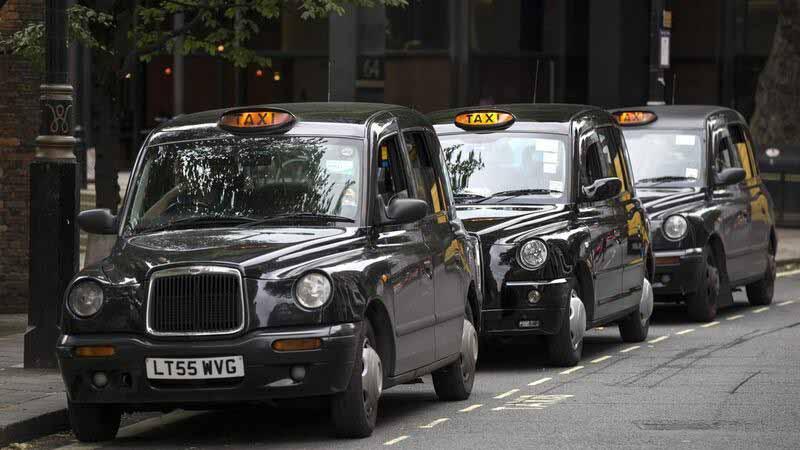
fractures, rallying drivers towards a sustainable business environment where knowledge, craft, and camaraderie triumph over algorithms.
Alas, enter the selfstyled “dog fighters” of the trade: figures like the Army boy of the United Cabbies Group (UCG), whose recent pronouncements reveal
role in our economy but it was dismissed outright, declaring such efforts unfit for “private companies” and citing a supposed “unanimous committee decision.” Unanimous? Hardly. This was no chorus of the collective but a voice unburdened by broader consultation, opposing a venture that could have funnelled vital support
ever more threadbare. He who once served as a trade rep for the LCDC and left before he was pushed, seeking refuge with the RMT— only to discover the taxi branch dismantled due to insufficient members, leaving it economically unviable and bereft of legitimacy—now peddles representation without roots, a hollow echo in a trade starved for authenticity.
Most damningly, I strongly believe he was self-elected, circumventing any democratic mandate; where, one must ask, is there democracy in such a self-anointed ascent, a farce that mocks the very principles of collective bargaining? The TikTok dancer cloaks division in virtue, the social media salvos over the past year a litany of selective outrage: endorsements of fragmented agendas that suit the inner circle, whilst branding dissenters as assailants on the vulnerable—a “single mother” trope deployed not for empathy, but to silence scrutiny. The other lost soul of the RMT chimes in sporadically, his contributions a thin veneer over the same fault lines. Their posts archived meticulously, a digital dossier of discord paint a portrait of reps more attuned to personal fiefdoms than future-proofing the trade. Where drivers demand collaborative strategies against TfL’s tariff reviews and EV transitions, these voices peddle unofficial edicts, fostering greed over togetherness.
“licence factories” flooding the market with underqualified rivals, deserve warriors who amplify their plight, not whisper it away.
This pattern of pious opposition extends to allies like the Tik Tok dancer of the LTDA and homeless Rep without office, whose credentials as trade stewards grow
Exemplifying this duplicity is the saga of the wardens scheme, a purported bulwark against drivers that complained it was unfair & biased towards the wardens. This farce was championed through orchestrated YouTube conferences platforms more performative than productive, broadcasting polished narratives to an audience of the already
convinced. There, the disciples echoed the chorus, touting the scheme’s triumphs with false accusations and statements, insisting it hummed with efficiency and equity. In truth, it was a gilded cage for the elite: a mechanism engineered for personal gain, where these stewards secured two free rides within a mere two hours of “duty,” whilst rank-and-file drivers toiled three, four, even five hours between fares, their pockets emptied to subsidise the very enforcers meant to protect them.
When pressed for transparency simple demands to inspect the logbooks, to tally the rides claimed they deployed every evasion in the book: deflections, delays, and denials, all whilst swearing under oath that no such two-hour shifts yielded such perks. This was no oversight; it was orchestration, a scheme that drained the trade’s lifeblood to fatten a select few, all under the guise of guardianship. Such conduct isn’t mere mismanagement its malfeasance, a betrayal that erodes the foundational trust upon which our profession rests, much like the opaque dealings that have toppled regimes from Westminster to the wider world.
Contrast this with the tireless efforts of organisations like Unite the Union and the LCDC, who have been steadfast in advocating for enhanced opportunities at Heathrow—pushing for a more visible presence to counter the aggressive tactics of Uber and other ride-hailing services that dominate terminal visibility. We all recognise the natural trademark of the iconic black cab, yet we yearn for a return to proven strategies: taxi desks and marshals inside terminals to deter illegal touts and serve as ambassadors to the over 80 million annual passengers. The
figures are alarming: yearly movements at the taxi feeder park have plummeted by at least 20% this year alone, from peaks nearing one million to barely over 600,000 if fortune favours us a stark decline amid record airport passenger numbers, underscoring how our trade is being sidelined. But Army boy and his cohorts eschew strategic foresight for the trade’s benefit, opting instead for manoeuvres that dismantle progress,
of inversion: claiming unanimity in solitude, unity in isolation, progress in paralysis. It mirrors the geopolitical blunders of our age leaders who, like certain NATO fringes, undermine alliances for short-term gains, leaving the front lines exposed. In the taxi trade, the cost is existential: licences teetering on revocation, from regulatory overreach, from the toxic residue of nasty, occasionally racist barbs that erode public trust
such figures—promised protection but delivered division, assured advocacy but granted only self-interest. It is time for every driver, every member, to pause and reflect: have these organisations truly served your needs, or have they perpetuated a cycle of decline under the veil of representation?
The evidence mounts, from thwarted promotions to opaque schemes, that the current guard

all because initiatives like London Taxi PR’s day collection threaten to curb their self-serving greed.
That collection was designed expressly for us—London black cab drivers at Heathrow—as one of many initiatives to ensure our vehicles are filled with paying passengers rather than left idle, fostering a vibrant and equitable business landscape.
This is the politics
and invite TfL’s scrutiny. Imagine the irony a body meant to safeguard fitness and propriety, undone by its own unfit stewards. Courts may one day convene over these archives, but the real verdict is rendered daily on our ranks on the terminals, where empty cabs and embittered drivers signal a trade adrift.
For too long, members of 3 of these orgs have been led astray by
with other unions willing to work together and other possible emerging unions, to demand what’s required for a prosperous and better environment at Heathrow.
We must adapt to market forces, to build a coalition for “pro-driver policies” that cap app fleets and elevate black cabs as cultural icons. Unfortunately, with these unprofessional figures at the helm of the other 3 Heathrow organisations they are dismantling our future; it is time for every driver to declare: enough is enough. Demand that your organisations listen to us, the drivers, not perpetuate self-elected reps unfit for the role.
We call for taxi desks in all terminals, a modest 50 pence or £1 extra from the gate to sponsor a dedicated police squad eradicating touts, volunteer marshals drawing on seasoned expertise to deter threats, and harnessing the promotional prowess of groups like London Taxi PR to burnish the image of our unique, iconic black cabs. This path will yield results, watch as work surges, unity prevails, and prosperity returns.
prioritises personal agendas over collective prosperity.
Yet herein lies our redemption: a clarion call to reclaim the wheel. Voices like Gary Long and Mark White, unafraid to challenge the echo chamber that is Heathrow, embody the trade’s true ethos, fierce, forwardlooking, and fiercely loyal to the driver. They remind us that politics, at its purest, is the art of the possible, forging pacts
Fellow cabbies, the road ahead gleams with potential for the Heathrow Taxi Trade, unfractured, steering towards equity and endurance. Let us discard the dog fighters for the dawn-bringers, trading division for deliberation, ignorance for insight. In unity, we do not merely survive the storms, we chart the course beyond them. The Knowledge is our compass let us drive as one, towards a horizon where every fare funds not just a livelihood, but a legacy.
The trade endures, not through the noise of the few, but the resolve of the many. It is time to wake up, to question, and to act. Join the journey; the metre is running on renewal.
City of London Livery company The Worshipful Company of Hackney Carriage Drivers (WCHCD), has appointed Leigh Dargan as its new Master Hackney Carriage Driver with effect from 2nd September 2025.
Leigh takes over the position from the outgoing Master, Dan Heath, who’s year-long tenure in office has come to an end. Dan will however continue his service in the role of Deputy Master.
Leigh was made Master in a ceremony prior to the Installation Dinner at the historic Cutler’s Hall (which dates back to 1285 and is the hall of residence for the Cutlers Company, one of London’s oldest livery companies).
Leigh is not only a London Taxi driver, having passed The Knowledge in 2022, but she was also a former Rugby player with Saracens, Irish Exiles and the Ireland Grand Slam Team, and was also Regional Sales Manager for both Sovereign Automotive and Proximo
prior to studying to become qualified as a Taxi driver.
Leigh is also only the fourth woman in the company’s history to be named as Master.
The WCHCD is the 104th Livery Company of the City of London, having received its grant in 2004 and then its Royal Charter in 2013.
The company has a charitable trust managed by trustees, of which the main event is The Magical Taxi Tour, now in its 31st year, which sees London Taxis take around 200 children, many of whom are suffering from either debilitating illness or life-limiting conditions, on a three-day trip to Disneyland Paris.
The WCHCD also has an educational affiliation with the Royal Docks Academy in Newham, which it is actively involved in helping the school and its students to develop and improve.
There is also a long established association with the military, and both

serving personnel and veterans, which goes back to Private Frederick Hitch, of the 2nd Battalion 24th (2nd Warwickshire) Regiment of Foot who was awarded the Victoria Cross for his meritorious bravery at the battle of Rorke’s Drift and who, upon leaving the Army, became a Hackney Carriage Driver and proprietor, first with horse drawn cabs and then the new motorised vehicles.
In continuing to further forge this relationship, the WCHCD recently signed the Armed Forces Covenant, in the hope that this initiative will form the gateway to making the company a conduit for helping military personnel transition to civilian life and find a route into the Taxi trade.
Be it going through the knowledge to become London Hackney Carriage Drivers, or using skills learned in their military careers such as mechanics and engineering which can then be utilised as a foundation for a future career in the London Taxi profession.
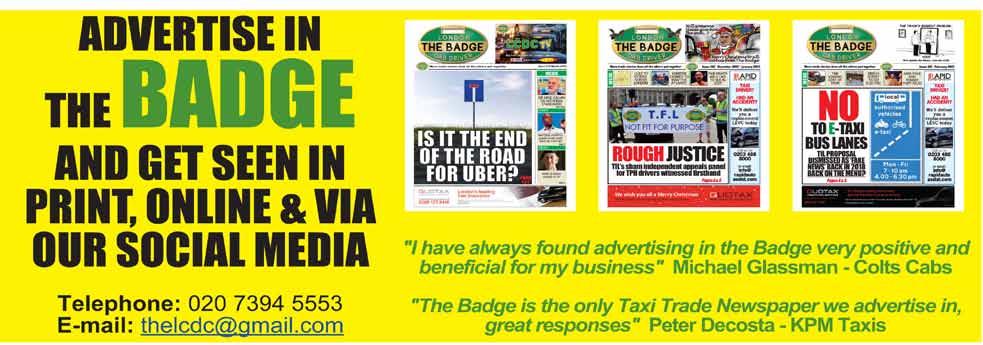






It feels like Dave Allen has had several remarkable boxing careers in the 13 years that he has been a professional heavyweight.
He has fought on the tiniest shows, in bad four and six-round fights in the sport’s forgotten lands, and he has also topped the bill at the O2 Arena.
During the last two years, he has met men with records like two wins and 25 defeats, and also been in a significant fight in Riyadh. He has been on boxing’s wayward train for about a decade, losing seven of his 33 fights on both sides of the tracks. His career has looked over a few times, and Allen has looked in danger of just vanishing.
On Saturday at the Utilita Arena in Sheffield, he is the star of the show when he fights Arslanbek Makhmudov, who not so long ago was considered one of boxing’s most lethal fighters.
Makhmudov has collected a lot of chilling and fearsome nicknames and has stopped or knocked senseless 19 of the 20 men he has beaten. He has actually won in the first round on 13 occasions and has clearly intimidated men with his size and attitude; he enters the ring like a wrestler, hissing and sneering and then, once the bell has sounded, flattens his victims.
Makhmudov stands about 6ft 6in or 6ft 7in and weighs in the region of 19st. He also looks like he could eat a galloping horse; there is a nice story about him wrestling bears for fun. It seems plausible, to be honest, given that there exists footage of UFC legend Khabib
Nurmagomedov doing the same as a child.
Allen, by contrast, often weighs in with a knitted hand puppet covering his privates. It’s a fun gimmick.
Allen has stopped 19 of the 24 men he has beaten; in May, Allen stopped Johnny Fisher, who was unbeaten in 13 and fighting in his backyard. The Fisher win secured him two things: a fight on his doorstep in Sheffield, and a dangerous opponent in the opposite corner. Allen’s promoter, Eddie
tickets for the Sheffield Arena have been sold. It is, even in a sport rich with fairytales, a remarkable story.
“It’s still all a bit of dream,” Allen said. “I’m in the main event at the Sheffield Arena against the beast.”
There was a time when Allen was on the heavyweight fringes, both popular and far better than he got credit for. In 2019, at the O2, Allen knocked out Australia’s Lucas Browne with a sickening body shot. Allen was the main event, tickets sold,
of highs and lows to get back into contention.
He admits he lost his way, and that is being kind; in truth, he is lucky to be back, lucky to be in Saturday’s fight. He is also fully deserving of his status as the main-event fighter.
Dave Allen from the summer of 2024 was never going to be in this position. He changed his attitude before the first Fisher fight last year in Riyadh, which he controversially lost on points, and was a different man for the rematch.

By Steve Bunce
In 2023, Makhmudov lost for the first time, and it was disturbing to watch from ringside as the giant, the latest “Beast from the East”, was broken down by Agit Kabayel’s short hooks to the liver, ribs and stomach. And then it happened again;

Hearn, admitted he was shocked when Allen picked Makhmudov, but it is a brilliant selection.
Allen last fought in Sheffield in July of 2024 in front of a few hundred at Skate Central; the fight was over after just four rounds – Allen won on points – against a man with eight wins and 14 defeats. For Saturday, it looks like nearly 9,000
the heavyweight division was fluid and Allen was in the mix – he was also a character and the public liked him.
After the Browne fight, there was bold talk about Allen’s plans, but he was stopped in his next fight by Dave Price and it looked like he had missed the window. It might sound harsh, but it is true. It has taken Allen five hard years
He now has Saturday’s big fight, and there is a genuine chance of a potential bout against former world heavyweight champion Deontay Wilder.
Talks have taken place, but first he must beat Makhmudov. This is a very different Allen: motivated, in shape and aware that he can no longer spend any time in boxing’s wilderness.
Makhmudov has a decent chin and a big, strong head, plus two lethal fists, but his long body is weak.
Since the last loss, Makhmudov has won once in the first round and remains a very real danger. Allen is taking a brilliant, calculated risk. The unwritten story here is that Makhmudov needs the win more – now that makes this a terrific fight.
If I posed the following question to Mrs Mumper ‘where do you fancy going for a nice slap up dinner’ and then gave her the choices of A. The Ritz, B. A Wimpy or C. The Ivy, I’d get a very fast reply of B!
We simply grew up in their establishments; they were our fast food of choice as young teenagers. With our high streets now heavily populated with every fast food restaurant and street food outlet you can think of, I’d still wager a good number of the UK population of a certain vintage, could be easily persuaded to settle down for a bit of nosebag from a Wimpy.
Mrs Mumper’s only prerequisite would be that the establishment of choice, would have to serve a Brown Derby to finish off any meal. I truly believe if you asked her what would her last ever meal on earth be, she’d say a Brown Derby. She is simply besotted with that warm doughnut topped off with ice cream, chocolate sauce and a healthy sprinkling of chopped nuts.
Us in the Deep South, once had a multitude of Wimpy’s on our doorsteps, with Walworth Road and Brixton, being the two most frequently visited locations.
I was also over in the West End from a very young age and around Berwick Street market fairly regularly, and I have a vague memory of there being two Wimpy’s down there at the same time? I’m sure a Sohoite will let me know if I’ve dreamt that as soon as this Blog appears on-line.
I distinctly remember the boys from the market always being in there, hogging the shop phone and placing their horse and dog bets. The wall by that phone was covered with various telephone numbers. A work of art

that was and if claimed by Bansky, would sell for millions.
I would also get into the one in Brighton on my frequent visits down there reliving Quadrophenia far too many times in my head, in the days when Mod completely ruled my swede.
Sadly, in the last few years, quite a few Wimpy Bars (and I’ll always call them that) have closed up and gone for good. But, I’m pleased to report there is a healthy following of those that remain.
I often see mention of a visit or two on social media and before you know it, there is a long thread of comments on the merits of the bender in a bun, the all day breakfast, and occasionally if flush, the international grill.
At the last count in 2019, there were 67 remaining restaurants in the UK. The nearest to us in SE5 are the ones in Streatham, which does a very fair burger and has been in the same family (thank you Gary Horwell) for many years, and in the ‘Blue’ near to Southwark Park, which
certainly has its fans and admirers.
So where did it all begin I hear you ask? Well, Bloomington, Indiana in America is the answer. Opened in 1934 and
Chicago alone.
‘Lyons Corner House’ picked up the licence to trade as the ‘Wimpy Bar’ in the UK in 1954 and this was the first time the teenagers of that time

known as ‘Wimpy Grills’ its proprietor, one Edward Gold, named it after J. Wellington Wimpy, the character in the Popeye cartoons who loved his hamburgers. Growth was rapid for Mr Gold and by 1947, there were 26 Grills with eight million hamburgers a year crossing the counters in
on offer, which included frankfurters, that several stand alone Bars opened soon after and they went from strength to strength for a few years.
With the McDonalds chain arriving on our shores from 1974 however, the 500 or so Wimpy Bars then operating in the UK, began to lose their dominance of the market, though it had still retained a decent number of 380 locations in 1989.
Another rival, Burger King, then arrived, with many moving into Wimpy locations that were on the slide, pushing our favourite even further into decline.
Then a rebrand in 2007 brought the famous logo into line with its international cousins. And quite international it was too with at one stage, restaurants operating all over, including South Africa, Kuwait, France, Ireland, Holland, Germany, Australia, New Zealand, India and Israel.
The company no longer operates in many of these countries now however, as the rise of McDonalds simply won the war for the burger buck.
The chain also vanished from its homeland in the USA, when no one picked up the trademark there when founder Edward Gold died in 1977.
At its height there were as many as 1,500 locations worldwide and now, well, only a few remain.
got to taste a real deal burger, even if they came with table service and a knife and fork.
The first one operated within the ‘Corner House’ on Coventry Street, London W1, but such was the demand for its burgers, milkshakes and the other fast food
But I sense a resurgence coming and it’s obvious that those that remain are loved by the likes of Mrs Mumper and trust me, she aint ready to give up her Brown Derby just yet!
www.artgalleryclothing. co.uk/blog/

All under one roof
• Exclusive Insurance schemes
• Breakdown cover only £99
• Roadside assistance and recovery
• Recovery to any UK Location